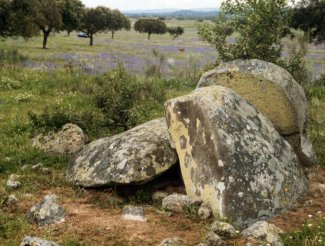

Home > Megalith
| The site
of Monte da Igreja is a small hill, some 10km south of Évora in the
Alentejo in southern Portugal. The most visible element of the site
is a megalith. It was presumably built during the Neolithic
period. |
|||
| The megalith
has previously been mentioned by Georg and Vera Leisner
in the 1950s as Anta 1 da Herdade da Igreja. Igreja means church:
the little church the name must refer to is about 2km south of the site.
Georg and Vera Leisner described the site as the remains of a passage-grave with a polygonal chamber, and a passage opening broadly to the East. Two side stones of the chamber and one stone of the passage appear to be in situ, with another large stone covering the area of the chamber but probably not in its original position. |
|
||
Around the megalith are various stones, of which only their upper parts are visible. They appear to be from the same material and (when kicking against them) are very solidly anchored in the ground. These could be further remaining stones of the megalith. Our project is, however, less interested in investigating the architectural and chronological details of the originally constructed megalith. For us, the megalith is significant mostly as a long-lasting monument that has seen various re-uses and re-interpretations over several thousand years, i.e. from the end of its primary use until the present day. |
|||
Leisner, Georg and Vera Leisner (1959) Die Megalithgräber der iberischen Halbinsel. Der Westen. Madrider Forschungen I, 2. Berlin: de Gruyter & Co. (pp. 182-3)
Webdesign © M E Chester-Kadwell 2001
